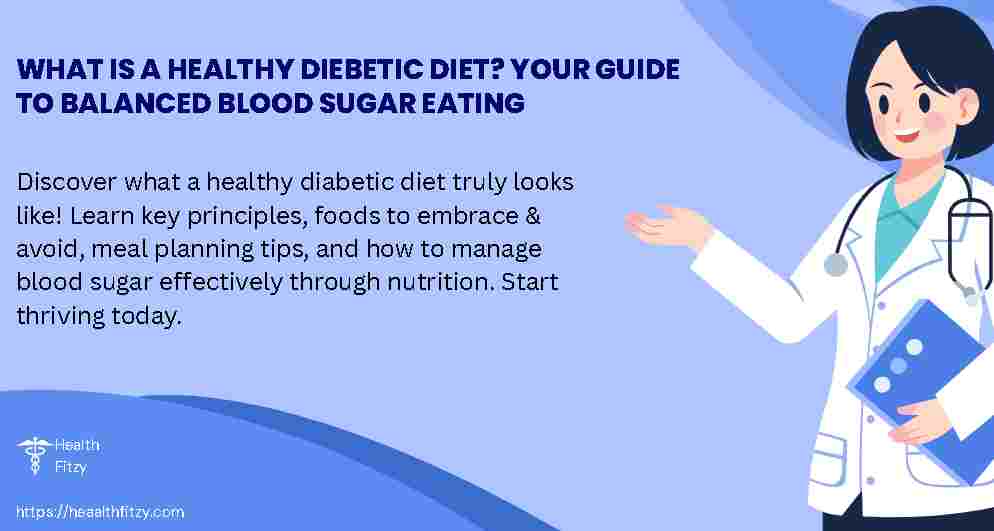What is a healthy diebetic diet? Your Guide to Balanced Blood Sugar Eating
what is a healthy diebetic diet: Managing diabetes effectively hinges significantly on what you eat. But a “pre diabetic diet” isn’t about deprivation or a single, rigid list of forbidden foods. Instead, a healthy diabetic diet is a balanced, nutrient-rich eating pattern focused on stabilizing blood glucose levels, maintaining a healthy weight, and supporting overall cardiovascular health. It’s about making informed, consistent choices that empower you to feel your best and reduce the risk of complications. Think of it less as a restrictive diet and more as a sustainable, health-promoting lifestyle.
Core Principles of Blood Sugar Management
The foundation of a healthy diabetic (pre diebetic diet) eating plan revolves around understanding how different foods impact your blood sugar and overall well-being:
-
Carbohydrate Awareness & Smart Choices: Carbohydrates have the most direct impact on blood glucose levels. A healthy diabetic diet prioritizes:
-
Complex Carbohydrates: Choose whole grains (oats, quinoa, brown rice, whole-wheat bread/pasta), legumes (beans, lentils), and non-starchy vegetables (leafy greens, broccoli, peppers, mushrooms). These digest slowly, providing sustained energy and causing gradual blood sugar rises due to their fiber content.
-
Fiber Focus: Aim for high-fiber foods (25-30+ grams daily). Soluble fiber (found in oats, beans, apples, berries) is particularly beneficial as it slows sugar absorption and improves insulin sensitivity.
-
Limiting Refined Carbs & Sugars: Minimize intake of sugary drinks (soda, juice), sweets, white bread, white rice, and highly processed snacks, which cause rapid blood sugar spikes.
-
-
Lean Protein Power: Protein helps stabilize blood sugar, promotes satiety (feeling full), and supports muscle maintenance. Include sources like:
-
Skinless poultry (chicken, turkey)
-
Fish (especially fatty fish like salmon, mackerel, sardines rich in omega-3s)
-
Eggs
-
Lean cuts of beef or pork
-
Tofu, tempeh, and edamame
-
Low-fat dairy or fortified plant-based alternatives (Greek yogurt, cottage cheese)
-
-
Heart-Healthy Fats: Not all fats are created equal. Focus on unsaturated fats which support heart health and can improve insulin sensitivity:
-
Monounsaturated fats: Avocados, olive oil, canola oil, nuts (almonds, cashews), seeds (pumpkin, sesame).
-
Polyunsaturated fats: Fatty fish, flaxseeds, chia seeds, walnuts, sunflower oil.
-
Limit saturated fats (found in fatty meats, full-fat dairy, butter, coconut oil) and avoid trans fats (often in processed snacks and fried foods).
-
-
Abundant Non-Starchy Vegetables: These are nutritional powerhouses – low in calories and carbs, high in vitamins, minerals, antioxidants, and fiber. Fill half your plate with vegetables like spinach, kale, broccoli, cauliflower, asparagus, green beans, tomatoes, onions, and peppers.
Foods to Embrace for Optimal Health
Building your meals around these nutrient-dense choices forms the bedrock of a pre healthy diabetic diet:
-
Non-Starchy Vegetables: The more color and variety, the better! Aim for at least 3-5 servings daily.
-
Whole Grains: Choose 100% whole grain options for bread, pasta, cereals, and crackers. Portion control is key.
-
Lean Proteins: Include a moderate source with each meal and snack.
-
Healthy Fats: Use oils for cooking/dressings, add avocado slices, and include a small handful of nuts or seeds daily.
-
Low-Glycemic Fruits: Enjoy fruits like berries, apples, pears, oranges, and peaches in moderation (1-2 servings per day), ideally paired with protein or healthy fat.
-
Legumes: Chickpeas, lentils, and beans are great providers of fiber and protein.
-
Water & Unsweetened Beverages: Stay hydrated! Choose water, unsweetened tea, or black coffee.
Foods to Limit or Avoid
To maintain stable blood sugar and support heart health, it’s wise to minimize:
-
Sugary Drinks: Soda, fruit juice, sweetened tea/coffee, energy drinks.
-
Refined Grains: White bread, white rice, regular pasta, pastries, sugary cereals.
-
Highly Processed Snacks: Chips, cookies, candy, cakes, ice cream.
-
Fried Foods: Often high in unhealthy fats and calories.
-
Excessively Fatty Meats: Processed meats (sausage, bacon, deli meats), fatty cuts of red meat.
-
Excess Salt (Sodium): Can contribute to high blood pressure. Read labels and limit added salt.
Practical Strategies for Meal Planning & Success
Putting principles into practice makes managing diabetes sustainable:
-
The Plate Method: A simple visual guide for balanced meals:
-
Half your plate: Non-starchy vegetables.
-
One quarter of your plate: Lean protein.
-
One quarter of your plate: Complex carbohydrates (whole grains or starchy vegetables like sweet potato).
-
Add: A small serving of healthy fat and/or a serving of fruit.
-
-
Portion Control: Even healthy foods impact blood sugar in large amounts. Use measuring cups, scales, or visual cues (e.g., a serving of cooked pasta is about the size of your fist) initially.
-
Regular Meal Timing: Eating meals and snacks at consistent times helps prevent extreme blood sugar highs and lows. Avoid skipping meals.
-
Smart Snacking: Choose snacks that combine protein, healthy fat, and/or fiber (e.g., apple slices with peanut butter, Greek yogurt with berries, small handful of nuts).
-
Read Nutrition Labels: Pay close attention to serving sizes, total carbohydrates, fiber, and added sugars.
-
Cook More at Home: This gives you the most control over ingredients and preparation methods. Focus on baking, grilling, steaming, or sautéing instead of frying.
-
Monitor and Adjust: Regularly check your blood sugar as directed by your healthcare team. This feedback helps you understand how different foods and portion sizes affect you personally.
The Importance of Individualization and Professional Guidance
There is no single “perfect” diabetic diet that fits everyone. Factors like your type of diabetes, activity level, medications, other health conditions, cultural preferences, and personal goals all play a role. This is why working with your healthcare team is essential:
-
Registered Dietitian Nutritionist (RDN): An RDN, especially one certified in diabetes care (CDCES), is your best resource. They can create a personalized meal plan tailored to your specific needs, preferences, and lifestyle.
-
Doctor or Certified Diabetes Care and Education Specialist (CDCES): They work with you and the RDN to ensure your diet aligns with your medication regimen and overall diabetes management plan.
Thriving with a Healthy Diabetic Diet
A pre healthy diabetic diet isn’t about restriction; it’s about empowerment. By focusing on whole, nutrient-rich foods, practicing mindful portion control, and understanding how your body responds, you gain powerful tools to manage your blood sugar effectively. This approach not only helps control diabetes but also promotes sustained energy, a healthier heart, better weight management, and an overall improved quality of life. Start incorporating these principles today – your body will thank you.
Disclaimer: This information is for educational purposes only and is not a substitute for professional medical advice, diagnosis, or treatment. Always consult with your physician or a qualified healthcare provider before making any significant changes to your diet or diabetes management plan.
What Is a Healthy Meal for Diabetics? A Balanced Guide to Blood Sugar Control

What Makes a Meal “Healthy” for Diabetics?
For people with diabetes, a “healthy meal” prioritizes balanced blood sugar levels, nutrient density, and sustainable eating habits. Unlike restrictive diets, diabetic-friendly meals focus on strategic combinations of high-fiber carbohydrates, lean proteins, and healthy fats to prevent glucose spikes. The American Diabetes Association (ADA) emphasizes individualized plans, but core principles apply universally: low glycemic impact, portion control, and whole foods.
Key Components of a Diabetes-Friendly Plate
Build meals using the “Plate Method” (recommended by the ADA):
-
Non-Starchy Vegetables (50% of plate):
-
Examples: Spinach, broccoli, peppers, cauliflower.
-
Why: Rich in fiber, vitamins, and minerals with minimal carbs.
-
-
Lean Protein (25% of plate):
-
Examples: Grilled chicken, tofu, fish, lentils, eggs.
-
Why: Slows digestion, stabilizes glucose, and promotes fullness.
-
-
High-Fiber Carbs (25% of plate):
-
Examples: Quinoa, black beans, sweet potato, berries.
-
Why: Fiber buffers sugar absorption. Opt for complex carbs (GI ≤ 55).
-
-
Healthy Fats (Small additions):
-
Examples: Avocado, almonds, olive oil.
-
Why: Boosts heart health without spiking glucose.
-
Sample Meal Ideas
Breakfast
-
Option 1: Greek yogurt (unsweetened) + ½ cup blueberries + chia seeds.
-
Option 2: Veggie omelet (spinach, mushrooms) + 1 slice whole-grain toast.
Lunch
-
Option 1: Large salad with grilled salmon, mixed greens, chickpeas, and vinaigrette.
-
Option 2: Lentil soup + side of steamed broccoli.
Dinner
-
Option 1: Baked chicken breast + roasted Brussels sprouts + ⅓ cup quinoa.
-
Option 2: Stir-fried tofu with bell peppers and cauliflower rice.
Snacks
-
Apple slices + almond butter
-
Hummus + cucumber sticks
Pro Tips for Success
-
Glycemic Index (GI) Awareness: Choose low-GI foods (e.g., oats over cornflakes).
-
Portion Control: Use smaller plates; measure carb servings (typically 15–30g/meal).
-
Timing Matters: Eat every 3–4 hours to avoid hypoglycemia.
-
Hydration: Replace sugary drinks with water/herbal teas.
-
Limit Processed Foods: Avoid hidden sugars in sauces, dressings, and packaged snacks.
Why This Approach Works
Balanced meals prevent extreme glucose fluctuations, reducing risks of hyperglycemia and insulin resistance. Studies show consistent, fiber-rich diets improve HbA1c levels by up to 2% (per Diabetes Care journal). Always consult a dietitian to personalize plans based on medication, activity, and health goals.
3 Day Mayo Diet Menu: Meal Plan, Safety & Realistic Results




Pingback: What Does a 1500 Calorie Diet Look Like? 7-Day Sustainable Plan